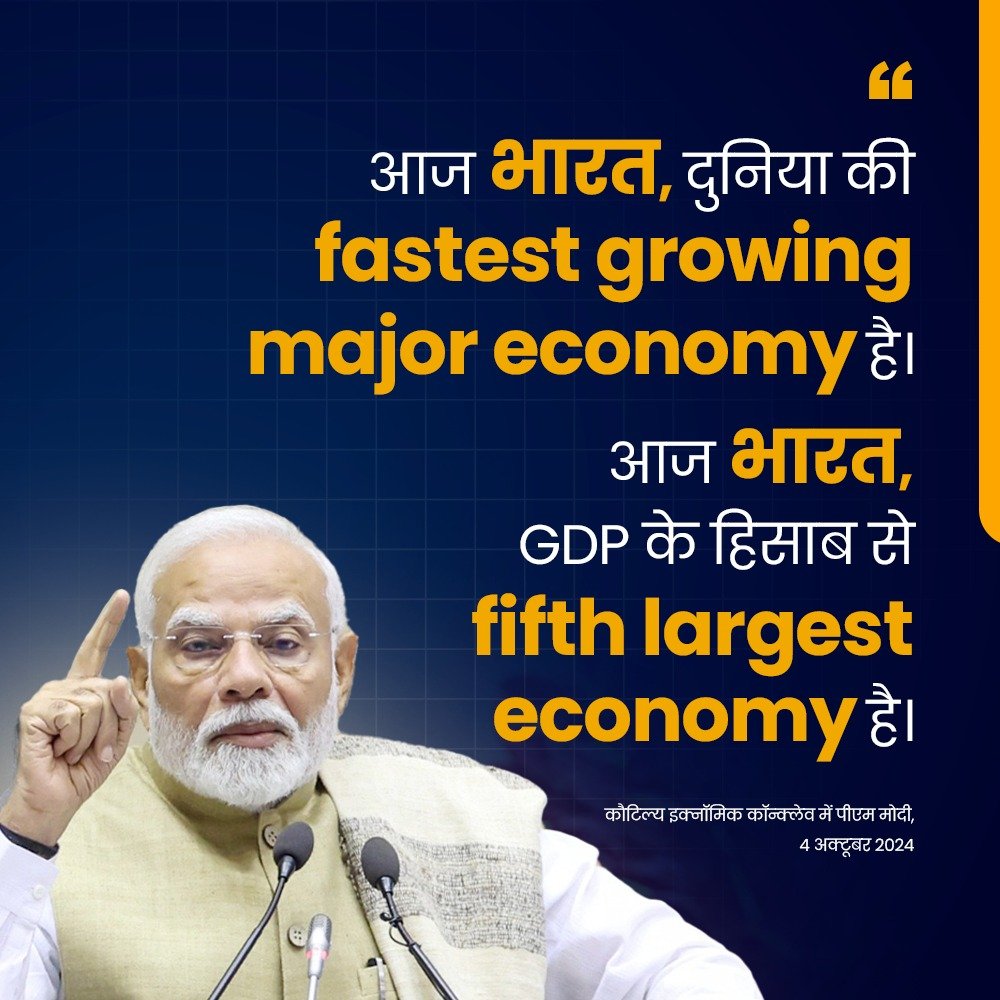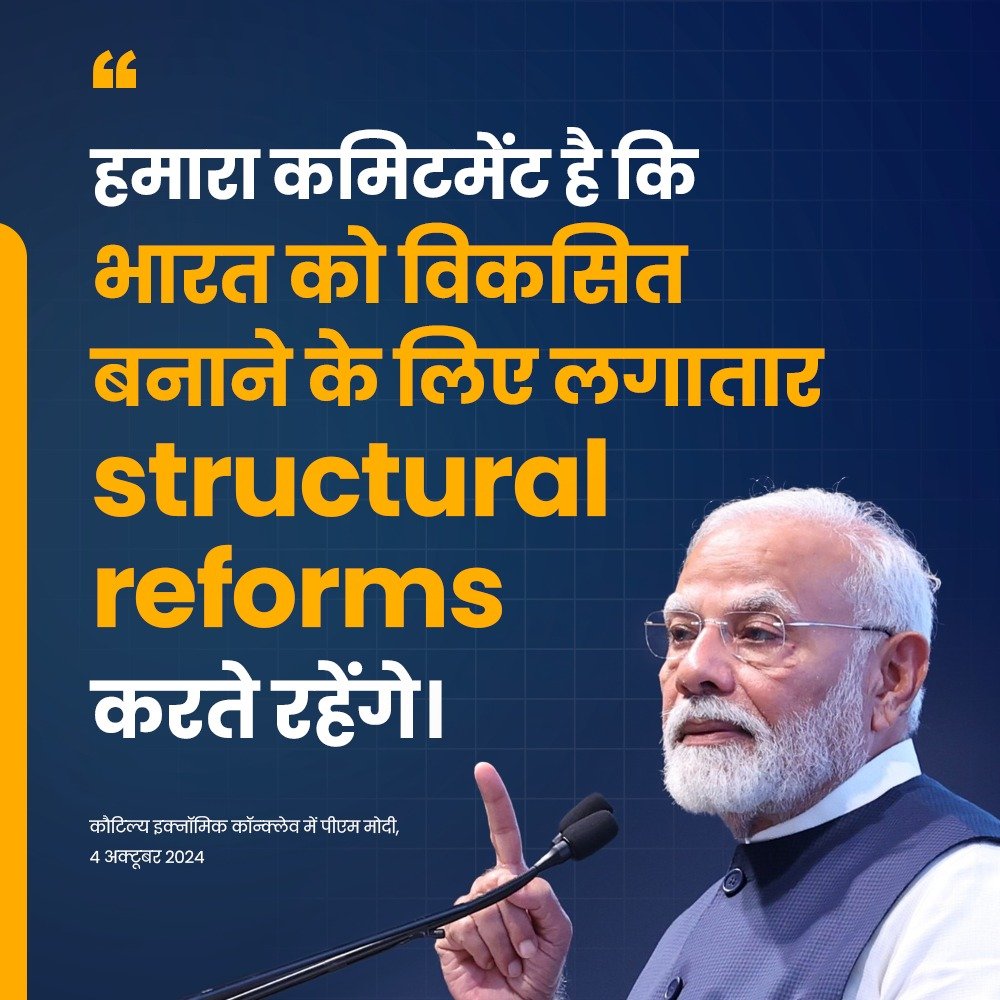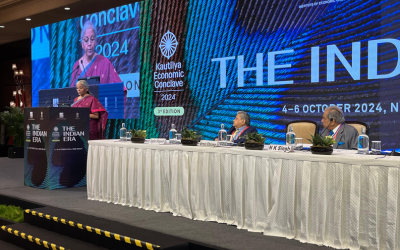Table of Contents
ToggleKautilya Economic Conclave 2024: PM Modi's Vision for Indian Economy
Prime Minister Shri Narendra Modi addressed the Kautilya Economic Conclave in New Delhi today. Organized by The Institute of Economic Growth in collaboration with the Ministry of Finance, the Kautilya Economic Conclave focuses on key themes such as financing the green transition, geo-economic fragmentation, and policy actions to maintain resilience.
In his speech, the Prime Minister expressed his gratitude for attending the third edition of the conclave. He highlighted that over the next three days, multiple sessions will delve into various economic issues, which he believes will significantly contribute to accelerating India’s growth.
Amidst global uncertainties, especially with two major regions at war impacting energy security, the Prime Minister emphasized the importance of discussing the “Indian Era.” He noted the growing trust and self-confidence in India today.
Addressing the Kautilya Economic Conclave. https://t.co/sWmC6iHAyZ
— Narendra Modi (@narendramodi) October 4, 2024
Shri Modi proudly stated that India is currently the fastest-growing major economy and the fifth largest in terms of GDP. He highlighted India’s leading position in global FinTech adoption and smartphone data consumption, as well as its rank as the s Prime Minister Shri Narendra Modi addressed the Kautilya Economic Conclave in New Delhi today. Organized by The Institute of Economic Growth in collaboration with the Ministry of Finance, the conclave focuses on key themes such as financing the green transition, geo-economic fragmentation, and policy actions to maintain resilience.
In his speech, Kautilya Economic Conclave, the Prime Minister expressed his gratitude for attending the third edition of the Kautilya Economic Conclave. He highlighted that over the next three days, multiple sessions will delve into various economic issues, which he believes will significantly contribute to accelerating India’s growth.
Amidst global uncertainties, especially with two major regions at war impacting energy security, the Prime Minister emphasized the importance of discussing the “Indian Era.” He noted the growing trust and self-confidence in India today.
Shri Modi proudly stated that India is currently the fastest-growing major economy and the fifth largest in terms of GDP. He highlighted India’s leading position in global FinTech adoption and smartphone data consumption, as well as its rank as the second-largest internet user base and the leader in real-time digital transactions.
Additionally, he mentioned India’s third-largest start-up ecosystem and fourth rank in renewable energy capacity. In manufacturing, India is the second-largest producer of mobile phones, two-wheelers, and tractors. He also emphasized that India, with its young population and vast pool of scientists and technicians, is at a sweet spot in science, technology, and innovation.

The Prime Minister also spoke about the government’s mantra of “Reform, Perform, and Transform,” which has been instrumental in the country’s progress. He credited this approach for the government’s re-election for the third consecutive time after 60 years. Shri Modi highlighted the government’s commitment to structural reforms, citing bold policy changes, a focus on jobs and skills, sustainable growth, innovation, modern infrastructure, and quality of life. He noted that decisions worth over ₹15 trillion have been made in the first three months of the government’s third term, including the initiation of mega infrastructure projects and the approval for constructing 3 crore new houses.
Shri Modi emphasized the inclusive spirit of India’s growth, noting that 250 million people have moved out of poverty in the last decade. He stressed that the government is ensuring that the benefits of development reach everyone, reducing inequality alongside rapid progress.
Highlighting predictions for India’s growth, the Prime Minister mentioned that institutions like the World Bank, IMF, and Moody’s have upgraded their forecasts for India, projecting continued growth despite global uncertainties. He expressed confidence that India will perform even better than these predictions.
The Prime Minister attributed this confidence to major reforms over the past decade, which have transformed India’s macroeconomic fundamentals. He cited examples such as banking reforms, the Goods and Services Tax (GST), and the Insolvency and Bankruptcy Code (IBC), which have strengthened financial conditions and created a new credit culture. Shri Modi also highlighted the opening of sectors like mining, defense, and space to private players and young entrepreneurs, as well as the liberalization of the FDI policy to attract global investors. He noted the government’s focus on modern infrastructure to reduce logistics costs and time, with unprecedented investments in infrastructure over the last decade.
Second-largest internet user base and the leader in real-time digital transactions. Additionally, he mentioned India’s third-largest start-up ecosystem and fourth rank in renewable energy capacity. In manufacturing, India is the second-largest producer of mobile phones, two-wheelers, and tractors. He also emphasized that India, with its young population and vast pool of scientists and technicians, is at a sweet spot in science, technology, and innovation.

Prime Minister Shri Narendra Modi emphasized the government’s commitment to continuous process reforms, highlighting the elimination of over 40,000 compliances and the decriminalization of the Companies Act. He mentioned the creation of a national single window system to streamline the process of starting and closing businesses and encouraged state governments to accelerate their own process reforms.
The Prime Minister discussed the significant impact of Production Linked Incentives (PLI) on accelerating manufacturing in various sectors. Over the past three years, these incentives have attracted investments of about ₹1.25 trillion, resulting in production and sales worth approximately ₹11 trillion. He noted the remarkable growth in India’s space and defense sectors, with over 200 start-ups emerging in the space sector and private companies contributing 20% to India’s defense manufacturing.
Highlighting the electronics sector, Shri Modi pointed out that India, once a major importer of mobile phones, now manufactures over 330 million mobile phones annually. He stressed that all sectors in India offer excellent opportunities for investors to achieve high returns.
Discussing critical technologies, the Prime Minister emphasized the government’s substantial investments in AI and semiconductors. He mentioned that India’s AI mission aims to boost research and skills, while the India Semiconductor Mission involves an investment of ₹1.5 trillion to establish five semiconductor plants, which will soon deliver Made in India chips globally.
Shri Modi also highlighted India’s emergence as a leading source of affordable intellectual power, with over 1,700 Global Capability Centres employing more than 2 million highly skilled professionals. He stressed the importance of harnessing India’s demographic dividend through education, innovation, skills, and research. The Prime Minister noted the significant reforms brought about by the New National Education Policy, including the establishment of a new university every week and two new colleges every day over the past decade. Additionally, the number of medical colleges in India has doubled in the last ten years.

Prime Minister Shri Narendra Modi emphasized that the government is not only increasing the number of educational institutions but also enhancing their quality. He noted that the number of Indian institutions in the QS World University Rankings has tripled, reflecting a strong focus on academic excellence. He also mentioned a special package for skilling and internships for millions of youth in this year’s budget. The PM Internship Scheme aims to provide one crore young Indians with real-world experience in major companies, with 111 companies registering on the first day.
Shri Modi highlighted the rapid growth in India’s research output and patents over the last decade. He noted that India’s ranking in the Global Innovation Index has improved from 81st to 39th position. To further strengthen the research ecosystem, a research fund of ₹1 trillion has been established.
The Prime Minister remarked on the global expectations from India regarding green jobs and a sustainable future. He mentioned the success of India’s G20 Presidency and the launch of the Global Biofuel Alliance, which received wide support. India aims to produce 5 million tons of green hydrogen by the end of the decade. The PM SuryaGhar Free Electricity Scheme, a rooftop solar initiative, has registered over 13 million families, turning them into solar energy producers. This scheme is expected to save families ₹25,000 annually and prevent significant carbon dioxide emissions, while creating around 17 lakh jobs.
Shri Modi emphasized the transformational changes in the Indian economy, driven by strong economic fundamentals. He expressed confidence that India is not only preparing to reach the top but also working hard to stay there. He stressed the importance of the inputs from ongoing discussions, which are integrated into government policies and governance. The Prime Minister concluded by thanking industry leaders and the team at the Institute of Economic Growth for their contributions (Kautilya Economic Conclave).
Union Minister of Finance, Smt Nirmala Sitharaman, and President of the Institute of Economic Growth, Shri N K Singh, were also present at the event.
The third edition of the Kautilya Economic Conclave is being held from the 4th to the 6th of October. Some of the most important issues confronting the Indian economy and economies of the Global South will be discussed by both Indian and international scholars and policymakers.
India is the fastest growing major economy
Government is following the mantra of Reform, Perform and Transform
Government is committed to carrying out structural reforms to make India developed
Inclusion taking place along with growth in India
India has made ‘process reforms’ a part of the government’s continuous activities
India’s focus is on critical technologies like AI and semiconductors
Special package for skilling and internship of youth
India has set ambitious green energy targets and has laid out a comprehensive plan to achieve them. Here are some key strategies and initiatives:
Renewable Energy Capacity:
Production Linked Incentives (PLI)
The government has introduced PLIs to boost manufacturing in various sectors, including renewable energy. This initiative has already attracted significant investments and is expected to accelerate production and sales.
Green Hydrogen:
India plans to produce 5 million tons of green hydrogen by 2030. This involves building an electrolyzer manufacturing capacity of 40 GW, which will more than double the global existing capacity.
Battery Storage
To support the renewable energy infrastructure, India aims to build 47 GW/236 GWh of battery storage capacity by 2031-32. This will help manage the intermittent nature of renewable energy sources.
Policy and Regulatory Support
The government has implemented favorable policies, subsidies, and incentives to promote renewable energy. This includes the decriminalization of the Companies Act and the creation of a national single window system to streamline business processes.
Infrastructure Development
A ₹2.44 lakh crore transmission plan has been introduced to support the energy transition. This plan includes the installation of extensive transmission lines and substations to ensure efficient energy distribution.
Global Biofuel Alliance
During its G20 Presidency, India launched the Global Biofuel Alliance to promote the use of biofuels. This initiative received wide support from member nations.
PM SuryaGhar Free Electricity Scheme
This rooftop solar initiative aims to turn millions of families into solar energy producers, saving them money and reducing carbon emissions. The scheme is expected to create around 17 lakh jobs3.
Research and Innovation
India has established a ₹1 trillion research fund to strengthen its research ecosystem. This fund supports advancements in critical technologies like AI and semiconductors, which are essential for the green energy transition.
These strategies reflect India’s commitment to a sustainable future and its efforts to become a global leader in green energy.



